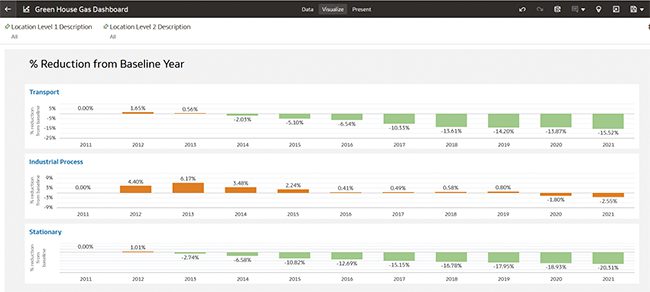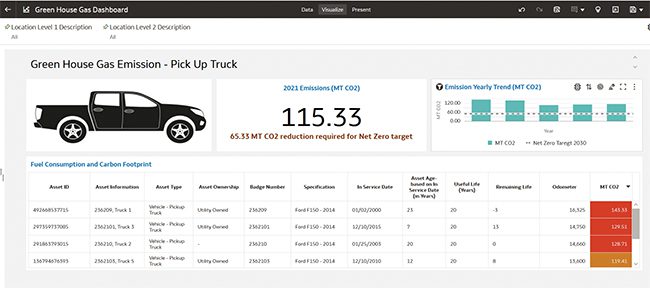Managers are constantly battling to improve efficiency and become more sustainable. Having effective asset management tools can help decision-makers visualize what’s working well and what isn’t, so fixes can be prioritized properly.
With utilities under pressure from consumers, regulators, and investors to progress toward more sustainable and socially responsible business operations, leaders recognize the constant need for calculated, needle-moving action. Impressively, the majority of U.S. utilities have committed to achieving net-zero targets by 2050 or sooner. However, despite utilities’ commitments to meeting net-zero targets, a lot of work remains to educate some stakeholders that carbon reduction plans even exist.
For example, according to the Smart Electric Power Alliance, 75% of U.S. customer accounts are served by an individual utility with a 100% carbon-reduction target, or a utility owned by a parent company with a 100% carbon-reduction target. In stark contrast, a J.D. Power Sustainability Index found that less than one-quarter (23%) of customers across the U.S. are aware their electric utility has declared a goal to reduce greenhouse gas (GHG) emissions, and less than half of these customers (46%) believe their utility is likely to achieve a goal of 100% clean energy by 2050.
So, how can utilities effectively accomplish and communicate real progress? While utility commitments to meet clean energy goals are unwavering, the real challenges for asset leaders come from first building a culture dedicated to change and determining the day-to-day tactical decisions that allow their organization to achieve strategic net-zero targets. Fortunately, Enterprise Asset Management (EAM) technologies exist today that give asset-intensive organizations such as utilities—where operations and maintenance accounts for a significant portion of their Scope 1 emissions (such as fleet, equipment, and buildings)—the ability to identify significant opportunities for improvement by optimizing asset management and supply chain practices.
 |
|
1. Trending greenhouse gas (GHG) emissions year to year can help decision-makers hit the necessary targets. Courtesy: Oracle Energy and Water |
Building Net-Zero Culture
In most cases, making net-zero strategic goals a reality requires a change in an organization’s culture. While each organization will approach this differently based on unique factors, including their size, training structure, and communication vehicles, it’s paramount to have an effective strategy in place and identify best practices to influence real change. For example, Capgemini Invent provides a “Sustainability Academy” to help organizations successfully drive employees’ adaption to a new business model, sustainability processes, governance requirements, and other strategic plan components.
As with any priority business program, sustainability-focused initiatives likely will be better received and more successful if employees, and all stakeholders, clearly understand an organization’s net-zero goals. Organizations must clearly explain the important forces at play and the outcomes the organization is committed to achieving. It’s powerfully motivating when organizations successfully build a true “esprit de corps,” and net-zero programs certainly lend themselves well to an ongoing, pride-building call to action.
At the employee level, organizations can help employees understand how they are part of the solution by providing clear examples such as explaining how emissions awareness will be increased in a new EAM solution the organization has selected. For example, asset and work managers who know that the necessary GHG emissions data will now be readily available to them on a daily basis will have higher confidence that their decisions can make a difference. This visibility can lead to change-making practices such as how to optimize the work schedule to reduce energy consumption, how to route the crews to reduce fuel consumption, and repair versus replace decisions for assets that are consuming more energy compared to other assets with similar duty cycle.
By demonstrating continued, strong executive support for programs and providing the tools they need (including training and ongoing education around regulatory requirements), employees will remain encouraged and empowered to play their important part. And, by celebrating accomplishments along the way to meeting key performance indicators (KPIs), employees receive the all-important satisfaction from knowing meaningful progress is being made.
 |
|
2. Tracking progress across sectors is important, as is being able to compare metrics to a baseline year. Courtesy: Oracle Energy and Water |
Visually Empowering, Data-Driven Paths
With a net-zero plan firmly in place, organizations must ensure they are using the right EAM solution to reliably support their strategy and best meet short- and long-term net-zero goals. It’s imperative for decision-makers to focus on technologies that enable easy ways to advance the most crucial elements of a strategic sustainability path. Two prominent elements include consistently monitoring and measuring GHG emissions and assuring transparency, completeness, and accuracy in data.
In our experience working with diverse utilities around the world, these features are best found in EAM solutions that provide powerful analytics through compelling visualizations for clear, insight-driven operational decisions. Because utilities are faced with volumes of digital world data, the challenge is how to effectively reveal the story that data is telling to help drive fast accurate decision-making. Analytics visualization helps provide a foundation to Asset Performance Management by providing a clear and immediate picture of asset health. This helps avoid costly disasters, improve uptime, and increase longevity—quicker, and at far less cost.
 |
|
3. Knowing which assets are underperforming allows managers to prioritize areas for improvement. Courtesy: Oracle Energy and Water |
The best solutions are ones that break down data silos for asset and operational device management, Geographic Information System (GIS), and mobile field service in one platform. Additionally, rather than settling for solutions that only offer the star schema for reporting, utilities should identify offerings that provide extensive pre-defined visualizations and base calculations. Pre-built visualizations allow users to filter data on countless criteria and use the calculations to quickly build custom visualization options.
With this approach, utilities can benefit from data that flows freely into the system from smart connected assets and devices to help identify and easily visualize infrastructure weaknesses throughout the lifecycle of the asset. Using data displayed on easy-to-consume dashboards, utilities gain the ability to bypass the need for costly data manipulation. And, with all the data coming from the same reporting structure, utilities can compare metrics and benchmark their performance against set goals and KPIs.
Technology in Action
When evaluating the right cloud native EAM solution, it’s essential to look at valuable use cases utilities can activate to benefit through meaningful daily activities. Following are three key examples of the types of capabilities asset leaders should require in the solution they ultimately choose.
A system should be able to use core data to measure Scope 1 emissions and leverage embedded analytics to visualize GHG emission details of all the owned and managed assets. The right system can track the GHG emission for industrial processes, stationary, and transport sectors, and their performance compared to the base year.
Utilities should be able to benchmark and track the progress of GHG emission reduction year over year (YOY) across sectors. Asset and sustainability managers need to be able to monitor YOY performance compared to the baseline year for all sectors.
Additionally, using the right system, utilities can identify bad asset actors (assets with higher GHG emissions compared to their peers) for remediation. This assists in comparing an asset’s emission level along with other important metrics such as remaining useful life and identifying targets for replacement.
Extending Vision to Sustainability Success
Asset operations leaders who cannot maximize the value of their assets are left with compromised investment decisions, reactive and costly work, and less reliable performance. This undoubtedly extends to sustainability efforts today, and it will be even more critical the rest of this decade and beyond. By embracing EAM solutions with enlightening data visualizations, leaders can take a vital first step in reliably evaluating their assets’ environmental impact. Empowered by data visualization that places emissions data at the front and center of operational decisions, leaders can then confidently cross the tactical bridge to meet strategic 2050 sustainability goals.
—Rahul Desai is director of product management (Asset Technologies), and Sudhanshu Goel is principal product manager, analytics, both with Oracle Energy and Water.











